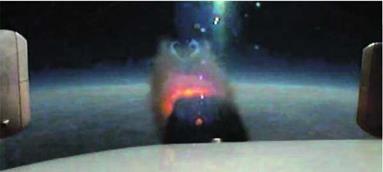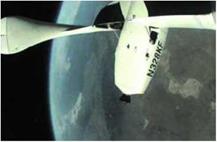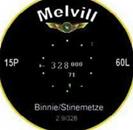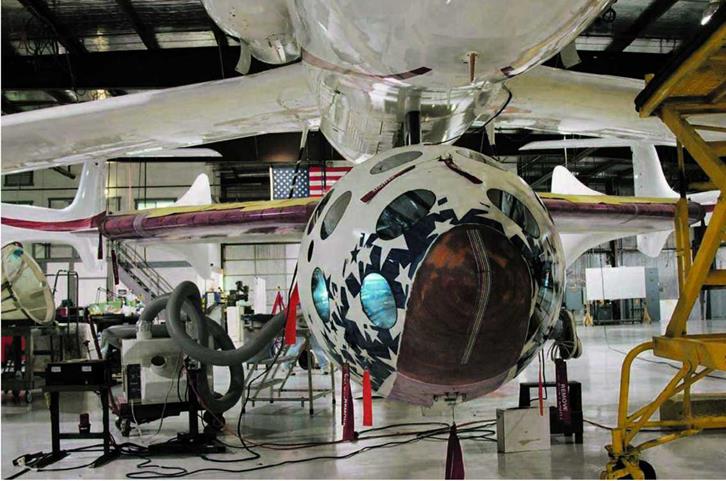Feather at Supersonic (14P)
Nearly one full year since flight testing began, SpaceShipOne was on the verge of making a spaceflight. One critical piece of information was missing, though. “The object of that flight was to do a supersonic feathered reentry,” Mike Melvill said. “We needed that data before we could go beyond that.” Figure 8.7 shows SpaceShipOne mated up to White Knight in preparation for the third powered flight.
Ten seconds after releasing from White Knight at 46,000 feet (14,020 meters), Melvill lit off the rocket engine. Figure 8.8 shows a dramatic rearward view of the rocket engine’s fiery plume and exhaust.
“During the boost after he reached the vertical part of the trajectory, the avionics display started flickering and then went blank,” Doug Shane said. “We all had good displays in the ground station. And Mike said, T looked out the window, and we were going pretty much straight up. So, I stayed with her.’ Gotta love a guy like Mike. Of course it came back on as soon as the motor shut down.”
The rocket engine burn duration was set by a timer. As Melvill looked out the windows to navigate, SpaceShipOne boosted to 150,000 feet (45,720 meters) and Mach 2.5, and then its rocket engine shut down. SpaceShipOne
r————————————————–
Flight Test Log Excerpt for 14P
Date: 13 May 2004
Flight Number Pilot/Flight Engineer
SpaceShipOne 14P Mike Melvill
White Knight 56L Brian Binnie/Matt Stinemetze
Objective: The third powered flight of SpaceShipOne. 55 seconds motor burn time. Handling qualities during boost and performance verification. Reaction control system use for reorientation to entry attitude. Supersonic feather stability and control.
|
Ґ

 |
Fig. 8.7. The photograph shows SpaceShipOne being prepared for its third rocket-powered test flight. SpaceShipOne had made its very first test flight just about a year earlier. The main goal of this test flight was to evaluate the performance of the feather at supersonic speed. Mojave Aerospace Ventures LLC, photograph by David M. Moore
г ^
 Fig. 8.9. SpaceShipOne reached an apogee of 211,400 feet (64,430 meters), and the video camera in the tail boom recorded the feather in the extended position. While high above Los Angeles, SpaceShipOne was technically not in space, even though the curvature of Earth can be clearly seen. However, the curvature is somewhat exaggerated due to the auto focus lens used. Mojave Aerospace Ventures LLC, video capture provided courtesy of Discovery Channel and Vulcan Productions, Inc.
Fig. 8.9. SpaceShipOne reached an apogee of 211,400 feet (64,430 meters), and the video camera in the tail boom recorded the feather in the extended position. While high above Los Angeles, SpaceShipOne was technically not in space, even though the curvature of Earth can be clearly seen. However, the curvature is somewhat exaggerated due to the auto focus lens used. Mojave Aerospace Ventures LLC, video capture provided courtesy of Discovery Channel and Vulcan Productions, Inc.
V_________________________________________________ J

reentry just as expected. It actually descended more smoothly at supersonic speeds than it did at subsonic speeds. Figure 8.9 shows SpaceShipOne above Earth, with Los Angeles and the California coastline in the background.
Back on the ground, engineers traced the avionics malfunction to a dimmer, a small electrical component. And since the thermal protection data looked good, Scaled Composites felt that SpaceShipOne performed well enough to continue forward.











